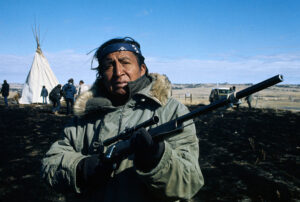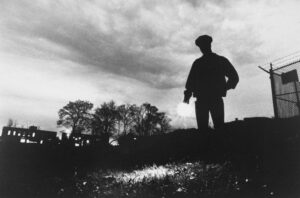“You have to be a neighbour to have a neighbour.” That’s Mark Jamison’s mantra — and he should know. Until he retired, after all, the 68-year-old was the postmaster in Webster, a small town enveloped by the mist and hollers of North Carolina’s Great Smoky Mountains. And while he surely dealt with letters and parcels, townsfolk brought Jamison their troubles too. The title of postmaster, he says, “gives you some heft” in a quiet place like Webster, where he was the only representative of the federal government. Between sorting mail, that authority meant he also wrote money orders for people who couldn’t read, or else deciphered tax statements. Sometimes, he just offered advice to the downtrodden or simply loosened the jars of old ladies driving home from the store.
And while many in Webster came specifically to see Jamison, they also used his post office to visit each other. So, as their postmaster, he installed benches, a community bulletin board, and a library. I ask him to explain himself; Jamison aw-shucked. “I figure if folks are talking to each other, it is hard to hate each other.” In truth, though, the Webster postmaster was merely fulfilling Title 39 of the US Code: “The United States Postal Service’s (USPS) purpose is to bind the nation together”. Lord knows that, in the aftermath of a brutal election, America needs some neighbourly ties. And Lord knows that few organisations do that as well as the Post Office, even if its triumphs hint at state failure elsewhere.
By sheer numbers alone, USPS is an American giant. With 33,904 post offices, it’s burrowed into every nook and cranny of the nation, from Kaktovik in Alaska to Ochopee in the Florida swamps. The country’s single biggest non-military institution, every day its army of 525,469 employees delivers mail to 167 million unique addresses. That’s even as USPS retains the so-called “Postal Principle” — meaning users pay the same fee no matter how far their package travels. No wonder Americans love the Post Office, with an eye-popping 91% of us viewing it favourably. By comparison, 29% of Americans support public schools, which is about equal to the 32% of citizens who have a positive opinion of God. “The Post Office is the last bastion,” says Erica Etelson, co-founder of the Rural-Urban Bridge Initiative. “It is still something everyone loves”.
For Professor Richard John, this isn’t incidental. As the Columbia professor and post office expert has written, the Founders always “intended the Postal Service to be a pillar of the republic, squeezing together millions of Americans, urban and rural, for the common good”. Created by Ben Franklin and the Continental Congress, the US Constitution explicitly calls for “Post Offices and Post Roads”. But, more than that, John says it’s the Post Office Act of 1792 that matters most. Because Congress deemed access to newspapers central to an informed public, the legislation kept postal rates low. This, John explains, ensured political parties wouldn’t dominate the news — while, as an apolitical institution, the Post Office could “follow the nation and stay close to the people”.
The Postal Service most certainly stayed close to the expanding republic. Between 1790 and 1840, the number of post offices exploded from just 75 to over 13,000. A few years after the Civil War, the service was operating over 76,000 offices. That, says Cameron Blevins, made it the largest “communication network” on earth. As the associate professor at the University of Colorado Denver explains, this was basically a function of 19th century expansionism. As the pioneers forced their way west, and Manifest Destiny rushed Americans from sea to shining sea, post connected the “whole nation together”. And so it proved in practice too. Consider Arizona’s Supai post office as an example. Established in 1896, it connected the Grand Canyon’s miners and the Havasupai nation of Native Americans to the wider world. 128 years later, mules still haul the outgoing mail three hours up steep, sandy passes to the next post at Peach Springs. Ten years after Supai’s founding, in 1906, free rural delivery integrated even more Americans. Just before the outbreak of the First World War, the Post Office started delivering parcels, further connecting people to the bounties of American life.
Public respect for the Postal Service reached further heights during the Great Depression, when FDR expanded its footprint still further. In truth, though, its acclaim during the first half of the last century isn’t really about numbers. In the Thirties, three-quarters of all Americans believed the federal government would “do the right thing almost always or most of the time”. Far from being naïve dupes, this civic faith was fired by depression and war, together creating remarkable social solidarity. At the core of this social trust were institutions, like the Post Office, that for Blevins represent the veritable cartilage and guts of the nation. “The US Post,” he says, “is a model of what an effective government could be.”
That, in turn, made Americans have more faith not just in far-off bureaucrats — but also in each other. For Americans born in the first half of the last century, neighbourliness and social trust flourished. Buttressing this sensibility was New Deal liberalism. More than a pastiche of programmes, the New Deal was grounded in a principle that Americans look beyond narrow self-interest and towards the common good. FDR, for his part, understood the Post Office was the one federal entity Americans most used, leveraging it as a tool of social solidarity.
During the Second World War, for instance, the Post Office offered “Victory Mail” to soldiers deployed overseas. Through the so-called V-Mail scheme, the Army Postal Service connected millions of troops to their families and loved ones — all free of charge. At home, the Post Office served as a hub for wartime information. Community boards posted draft posters, air raid instructions, and information about federal schemes. Postal workers added the sale of war bonds and war stamps to their duties.
It’s little surprise that public regard for the Postal Service reached its zenith in the early post-war era. As Richard John notes, the humble post office commanded so much respect that it’s used as a major plot device in the 1947 Christmas classic Miracle on 34th Street. “Santa Claus exists because the Post Office says so,” John explains. “It had unassailable credentials”.
In 1970, the Post Office’s golden age came to a screeching halt. A confluence of forces — postal worker strikes; delivery inefficiencies; Richard Nixon — resulted in the Postal Reorganisation Act. This transformed the Post Office Department into the United States Postal Service (USPS). The Postmaster General was moved out of the cabinet and into a boardroom, even though the new “postal corporation” remains a public service. Blevins calls this new creature a Frankenstein monster. “It is expected to provide a universal service,” he says, “but it is not funded to do so”.
In 1975, Americans encountered Frankenstein. A deep recession spurred massive postal deficits. To cover costs, bureaucrats planned to close 12,000 post offices — mostly in rural areas. Popular uproar forced them to scrap the plan. But the situation has hardly remained stable. With the profit motive now king, postage stamp prices have typically been raised three or four times a decade since 1970. From the turn of the millennium, meanwhile, the cost of sending a first-class letter has increased 18 times, even as the number of USPS employees has been cut almost in half. That’s unsurprisingly led to shuttered branches, shortened opening hours, and a delivery window for First Class letters that’s almost doubled.
Not, of course, that post offices have suffered alone here. On the contrary, the squeeze on USPS has been witnessed across the public sector and beyond. Ronald Reagan’s 1980 victory was merely a symptom of a sharp collapse in social solidarity. While Reagan’s neoliberals cut budgets aimed at the collective good, the proportion of unionised jobs had already fallen from a third in the Fifties to a quarter by 1980. Membership in civic clubs, from the Red Cross to the PTA, collapsed too. Unsurprisingly, time devoted to informal socialising spiralled downward. The ties that bind, from the Post Office to the coffee klatsch, withered.
This collapse in unifying institutions has affected Americans psychologically. These days, and in a far cry from the halcyon days of the New Deal, just 2% of Americans believe the federal government does the right thing “just about always”. That, of course, begs the question: amid so much cynicism, so much disdain for the powers-that-be, how is it that USPS has retained its place in the hearts of the nation? Ironically, and especially in rural areas, the answer might have something to do with the decline of public institutions generally.
For while, in 1940, Americans in the hills of Appalachia or the flat lands of Nebraska would have counted on the Rural Electrification Administration for power, or the Farm Home Administration for loans, to say nothing of churches and social clubs — for thousands of isolated communities the post office is all that’s left. It hardly helps, Jacobs says, that rural Americans rely on USPS far more than their urban peers. “There is material dependency,” he says, not least when even Amazon upon the USPS for unprofitable “last mile” deliveries right across rural America.
Certainly all this — the way post offices tie Americans both to their rulers and each other — helps explain the abiding power of folks like Mark Jamison. But so too, surely, does their individual hard work. As postmaster, after all, Jamison lived next door to his office. At night, he sat on the front porch strumming his guitar, his five dogs all there at his side. Neighbours would stop and seek his counsel. “I drew the line at getting packages at 10pm,” Jamison says. But anyone in Webster who needed a neighbour had one in their postmaster.
It’s something that’s becoming rarer every year. Social solidarity begins with civic society and ends with private friendships. In the 1830s, Alexis de Tocqueville was gobsmacked by Americans and their unerring sociability. But since 2000, the time Americans devote to socialising has collapsed by 30%. In 1990, nearly half of all Americans reported having five or more close friends. Today, slightly less than a quarter can say the same, even as 12% have no close pals at all.
That reality is surely true in Webster, North Carolina, a place that may yet lose even more. The town still has a building called a post office — but budget cuts mean it no longer has a postmaster. Now that Jamison has retired, there are no plans to replace him. Ultimately, then, the story of the post office speaks to a wider human disconnect. Those ties that bind, from postmasters up, are tattered and frayed. And without common places to meet, and chat, and get their jars opened, Americans have simply quit being neighbours. “I wish more neighbours trusted more,” Jamison says. “But they have good reason not to.”
Disclaimer
Some of the posts we share are controversial and we do not necessarily agree with them in the whole extend. Sometimes we agree with the content or part of it but we do not agree with the narration or language. Nevertheless we find them somehow interesting, valuable and/or informative or we share them, because we strongly believe in freedom of speech, free press and journalism. We strongly encourage you to have a critical approach to all the content, do your own research and analysis to build your own opinion.
We would be glad to have your feedback.
Source: UnHerd Read the original article here: https://unherd.com/



